The implications of this simple, seemingly mundane fact may not be immediately apparent, especially to designers in engineering offices who are charged with the day-to-day execution of smoke control system design. They may be unaware that the best solution to a smoke control problem may, in fact, have more to do with the architectural design of the atrium itself than with any mechanical system that could be provided.
Unless this is clearly understood, consulting engineers may find themselves following a dangerous and erroneous path in their attempt to satisfy poorly developed design criteria. The following example should serve to illustrate this concern.
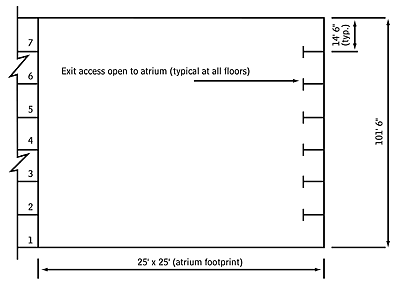
A Simple Atrium?
A designer was charged with the responsibility for designing a smoke control system for an atrium, its geometry represented in Figure 1. The project was to be constructed in an area where the governing building code is the BOCA National Building Code, 1996. The designer had carefully noted pertinent code requirements as shown in Figure 2. A sketch like Figure 3 was generated, and the code-prescribed analysis was performed to determine whether or not a passive smoke control system would meet BOCA requirements.The designer correctly concluded that a mechanical smoke control system was needed to meet code requirements. (The interested reader is referred to the publication titled The BOCA National Building Code/1996 Commentary, p. 9-69 through 9-72, for an advisory discussion of how the smoke-filling time can be conservatively estimated.)
For this case, it can be shown that the time required is a fraction of a second. The smoke production and consequent smoke exhaust airflow were calculated using the appropriate formula from BOCA ( 922.2.1.2). An exhaust requirement of approximately 381,000 cfm was determined (Figure 4). The design team was unable to overcome the following design challenges associated with that air quantity:
- Design of a suitable passive makeup air system was prohibited due to the limitations of available exterior surfaces and aesthetic considerations; and
- Costs attendant to an alternative mechanical makeup air system did not fit within budget constraints.
Years of experience with old code requirements led the designer to note that the calculated exhaust air quantity was almost a full order of magnitude greater than that which would have been code-compliant in the "old days." Perplexed with the situation, and under serious pressure from the CM and the project architect, the designer conducted research to find some way to reduce the required air quantity.
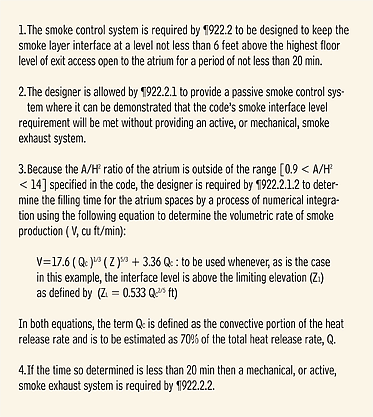
The Trouble Begins
The designer first looked for relief to BOCA Table 922.2.1. Unfortunately, because the ratio of the time "t" (smoke layer descent to Z in the presence of a mechanical exhaust system) to the time tO(smoke layer descent to Z in the absence of a mechanical exhaust system) was so great (t/tO> 10), no relief was available.Next, the 1995 edition of NFPA 92B was consulted. The designer found (in 3.8 "Influence of Plume Contact with Walls," Figure 5) what was thought to be the rationale for reducing the smoke exhaust air quantity that everyone was hoping for. The designer reasoned that the plume contact with the walls of the atrium enables the reduction of the term Z in the BOCA 922.2.1.2 formula from 93 ft to 50 ft, and he calculated a new exhaust airflow of approximately 139,000 cfm.
The designer and the architect determined that this amount of air could be passively supplied to the atrium, and the CM confirmed that there were no budget problems with the proposed system. In an apparent attempt to validate the proposed solution, the designer submitted a letter to BOCA requesting an opinion on the suitability of the proposed design approach.
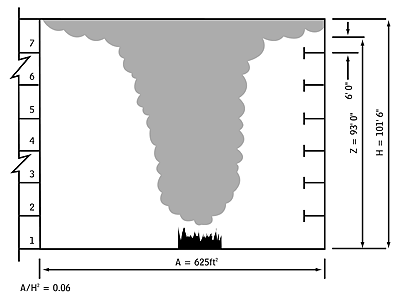
The Trouble Continues
The designer attached his sketches, and formulated the principal question in the following unfortunate manner:"Can NFPA 92B 3.8 be used to calculate the height (Z) to be used in the smoke production equations of BOCA NBC/1996 922.2.1.2 for tall atriums, where the smoke plume contacts the atrium walls before reaching the atrium ceiling?"
Not surprisingly, the BOCA reviewer's response was a carefully worded, "In my opinion, yes," accompanied by the necessary reference to NBC 922.2.4, "Alternative Systems." The following standard caveat was included as well:
"This opinion is based on the information which you have provided. We have made no independent effort to verify the accuracy of this information nor have we conducted a review beyond the scope of your question. As this interpretation is advisory, please consult the authority having jurisdiction, the code official."
Thinking that the reviewer's response provided some kind of confirmation of its suitability, the designer dutifully placed a copy in the project files and incorporated the proposed system design based on the new, lower air quantity as part of the contract documents.
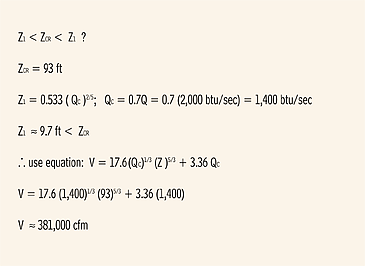
What's Wrong With This Picture?
The designer is to be commended for the research into NFPA 92B. Unfortunately, the application of that research was incorrect, as was the mistaken idea that it was somehow confirmed as a result of the communications with BOCA. Exactly what went wrong?The wording of the designer's inquiry resulted in the BOCA reviewer's furnishing no more information than could have been obtained if the designer had simply read NBC 922.2.4 himself. At best, the reviewer's response could be interpreted as acceptability of the use of the NFPA data; there was no indication that the way in which that data was used was acceptable. The designer would have been likely to receive a more meaningful response if the question had been something like, "Does the proposed atrium smoke control system satisfy the requirements of 922.2 and 922.2.1.2 of the 1996 NBC?" In any event, it is important to recognize that, regardless of the reviewer's response, professional responsibility for the smoke control system design rests solely with the CE firm.
Also, the principal flaw in the designer's application of the NFPA data is the failure to recognize the physical significance of the proposed alternative design. Figures 1 and 2 have been presented in this article in the same distorted scale that they were prepared. The author, in reviewing the original design, drew the atrium roughly to scale and superimposed the NFPA data on it, as shown in Figure 6, showing how smoke would be impinging on the atrium walls at approximately 50 ft above the floor.
The obvious question then, was how could a design such as this satisfy the fundamental BOCA requirement, in 922.2, to "keep the smoke layer interface above...6 feet above the highest floor level of exit access open to the atrium..."? The equally obvious answer is...it can't!
How, then, should the NFPA data have been used to develop a suitable smoke control system solution? Given that the geometry of the atrium in question was fixed, there would appear to be two approaches to potential solutions:
- Solution 1. Eliminate the opening of any exit access into the atrium from the fifth floor and above. This solution will require, and be dependent on, architectural design modification of the original atrium. One might imagine an architectural design which encloses the upper exit access levels with appropriate construction that includes glass so that the desired effect is at least partially retained. Whatever the final architectural design is, this approach would seem to be the only practical solution.
- Solution 2. Provide "opposing airflow" smoke control across all exit access openings into the atrium from the fifth floor and above, as suggested in NFPA 92B 2-1.2.2 (a)3. All such opposing airflow must then be added to the atrium exhaust airflow since it is being introduced into the atrium at a level above the smoke layer interface. This approach should not be considered unless the designer attains a thorough working knowledge of the details and limitations of the application of the opposing airflow design concept. Futhermore, it is not likely that this approach could be successful in keeping the portion of the exit access, within the atrium, free from smoke. (The interested reader is referred to the publication titled Design of Smoke Management Systems by Klote and Milke, published by ASHRAE and SFPE, as well as NFPA 92A and 92B for additional background and details.)
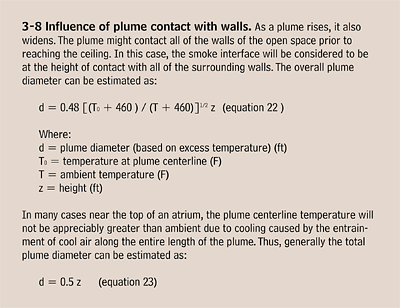
Lessons Learned
The sketch shown in Figure 6 is compelling evidence of the inadequacy of the designer's proposed solution. Even so, the author did some background research into the topic of 3.8 of NFPA 92B to see if printed guidelines were available on the application of the NFPA equation. In 4.7 of a paper titled, "Method of Predicting Smoke Movement in Atria with Application to Smoke Management" by John H. Klote (November 1994), Dr. Klote discusses the same topic as 3.8 of NFPA 92B. He suggests that the equation [DP = z/2] can be used to determine a solution, if the geometry of a specific space lends itself to the smoke management approaches of the paper.The "approaches of the paper" are the same as those of NFPA 92B, which are also the same as those found in the BOCA NBC. The equation (DP = z/2) should be seen to be the same as the NFPA 92B equation, namely, d=0.5z. Dr. Klote goes on to say:
"From equation [DP = z/2] it can be said that the atrium smoke management concepts of this paper are not appropriate for spaces that are taller than twice their minimum width."
This guideline would seem to indicate that, for atria with a square footprint, the code-required exhaust air quantities would not be appropriate when A/H2 ratios are less than 0.25. Perhaps the most important lesson to be learned from this example is that the esoteric science of smoke management does not lend itself to cookbook application of random topics. The foreward to the text titled Design of Smoke Management Systems is highly recommended, as it is an eloquent and wise elaboration of the sentiments found here.
Lessons from this example include:
- Smoke control system design for atria with low A/H2 ratios must be carefully analyzed;
- Always look for the physical significance of any proposed smoke control system solution;
- Smoke control in atria can be as much an architectural issue as it is a mechanical issue; and
- Never depend on a code agency review for validation of an engineering design approach.
 Figure 6. Proportionate representation of the geometry of the example atrium, showing smoke contact with walls.
Figure 6. Proportionate representation of the geometry of the example atrium, showing smoke contact with walls.One More Question
The obvious follow-up to the given example is, what if there had been no problem in designing a passive makeup air system for the original 381,000 cfm requirement? Would a system designed for the higher airflow be correct?The answer is...it depends on what "correct" is! Such a system would meet BOCA's prescriptive requirements but not its performance requirements. It seems reasonable to infer that "correct" means that the smoke layer interface is to be controlled to meet BOCA's performance requirement. Installation of any system which was known not to meet this requirement would not be recommended. ES
